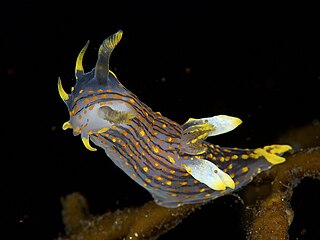
Dirona is a genus of sea slugs, Pacific Ocean nudibranchs, marine, opisthobranch gastropod mollusks in the family Dironidae.

Acanthodoris lutea, the orange-peel doris, is a species of nudibranch or sea slug, a shell-less marine opisthobranch gastropod mollusk in the family Onchidorididae.

Peltodoris nobilis, commonly called the sea lemon, false sea lemon, or the noble dorid, is a species of colorful sea slug, a dorid nudibranch, a shell-less marine gastropod mollusk in the family Discodorididae.

Rostanga pulchra is a species of sea slug, a dorid nudibranch, a shell-less marine gastropod mollusk in the family Discodorididae.

Acanthodoris hudsoni is a species of sea slug, a dorid nudibranch, a shell-less marine gastropod mollusc in the family Onchidorididae.

Diaphoreolis flavovulta, the yellow-head aeolid or yellow-head cuthona, is a species of sea slug, an aeolid nudibranch, a marine gastropod mollusc in the family Trinchesiidae.

Polycera faeroensis is a species of sea slug, a dorid nudibranch, a shell-less marine gastropod mollusk in the family Polyceridae.

Polycera is a genus of sea slugs, specifically nudibranchs, shell-less marine gastropod molluscs in the family Polyceridae.

Limacia cockerelli is a species of sea slug, a dorid nudibranch, a shell-less marine gastropod mollusc in the family Polyceridae.

Cadlina flavomaculata, common name the yellow-spot cadlina, is a species of colourful sea slug, a dorid nudibranch, a shell-less marine gastropod mollusk in the family Cadlinidae.

Okenia rosacea, commonly known as Hopkin's rose nudibranch, is a species of sea slug, specifically a dorid nudibranch, a marine gastropod mollusc in the family Goniodorididae.

Frank Mace MacFarland (1869–1951) was an American malacologist associated with Stanford University in California. Born in Centralia, Illinois, MacFarland attended DePauw University, Stanford University and the University of Wurzburg. On August 27, 1902, MacFarland married Olive Knowles Hornbrook. Mrs. MacFarland was a skilled technician and artist whose delicate watercolor paintings illustrated many of his scientific publications.

Polycera aurantiomarginata is a species of sea slug, a nudibranch, a marine gastropod mollusk in the family Polyceridae.
Polycera aurisula is a species of sea slug, a nudibranch, a marine gastropod mollusk in the family Polyceridae.
Polycera anae is a species of sea slug, a nudibranch, a marine gastropod mollusc in the family Polyceridae.

Polycera hedgpethi, common name Hedgpeth's dorid, is a species of nudibranch, a shell-less marine gastropod mollusk in the family Polyceratidae.

Aegires albopunctatus, common name salt-and-pepper doris, is a species of sea slug, an Eastern Pacific Ocean nudibranch, a marine, opisthobranch gastropod mollusk in the family Aegiridae.

Doriopsilla fulva is a species of dorid nudibranch, a sea slug, a shell-less marine gastropod mollusk in the family Dendrodorididae.

Doriopsilla gemela is a species of dorid nudibranch, a colourful sea slug, a shell-less marine gastropod mollusk in the family Dendrodorididae.
Polycera tricolor, commonly known as the three-color polycera, is a species of sea slug, a nudibranch, a shell-less marine gastropod mollusc in the family Polyceridae. It occurs in the Pacific Northwest, ranging from southern Alaska southward to northern Mexico, at depths down to about 60 m (200 ft).


















